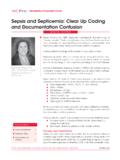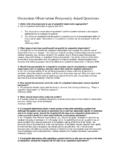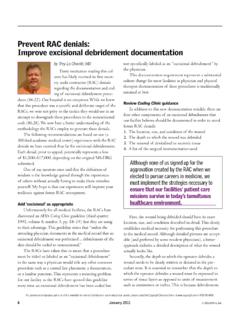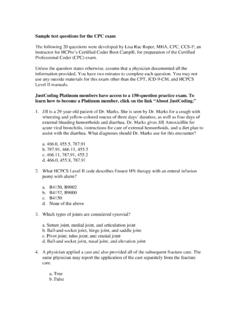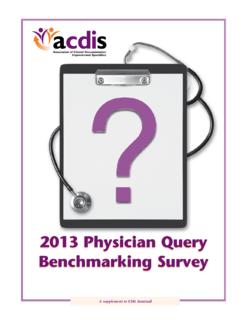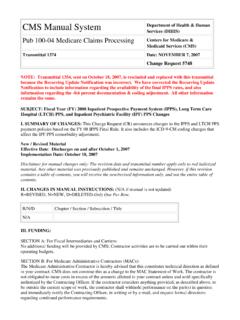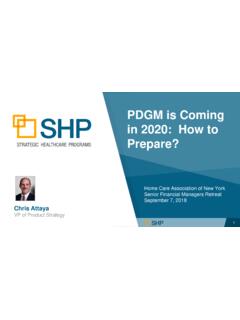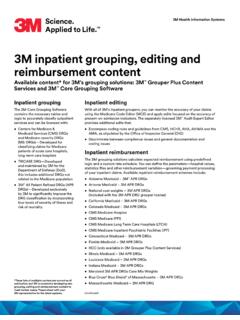Transcription of Coding Clinic update - HCPro
1 Coding Clinic update January 2010 Editor s note: The following article is provided as a supplement to the January CdI the second of a quarterly series of articles available to ACDIS members, James S. Kennedy, Md, CCS, managing director at FTI Healthcare in Atlanta, takes a look at the highlights from the fourth quarter 2009 issue of AHA Coding Clinic for ICD-9-CM as they relate to CDI. This quarter fea-tures an added emphasis on documentation at the time of discharge, CDI opportunities in diabetic patients, and changes to Coding and reporting of obstetrics of uncertain diagnoses at the time of discharge (p. 172)Many CDI specialists are under the mistaken impression that uncertain diagnoses ( , those qualified as possible, probably, likely, suspected, still to be ruled out, or other similar terms) can be coded if they are documented anywhere in the record.
2 That is not true, given that the fourth quarter 2009 Coding Clinic and the ICD-9-CM Official Guidelines for Coding and Reporting (since at least 2000) both emphasize that diagnoses must be documented at the time of dis-charge in order for a coder to report them. This Coding Clinic emphasizes that the present-on-admission (POA) indica-tor is affected as well. If the final diagnosis (note the word final ) contains a possible, probable, suspected, or rule-out diagnosis, and this diagnosis was based on signs, symptoms, or clinical findings suspected at the time of inpatient admission, a coder may assign a POA indicator of Y. On the other hand, if the final diagnosis (again, note the word final ) contains a possible, probable, suspected, or rule-out diagnosis, and this diagnosis was based on signs, symptoms, or clinical findings that were not POA, a coder must assign N.
3 Although this information is not new, it is now bolded in the ICD-9-CM Official Guidelines for Coding and Reporting, lending it further statement at the time of discharge does not imply that the diag-noses must be documented in the discharge summary in order for them to be coded, Kennedy says. Discharge notes, discharge orders, or similar documents are sufficient. The bottom line is, a physician can document an Coding Clinic updateConditions documented at the time of discharge, diabetes opportunities highlight important updates for Cdi specialistsWhIte paper Uncertain diagnoses at time of discharge 1 Neuroendocrine tumor with MeNS 2 Benign carcinoid tumor of lung 3 Diabetes with LOpS 3 Obstetrics 3 Changes to ICD-9-CM guidelines 4 FeatUreSBrian Murphy, CPC director, aCdIS, HCPro , Inc.
4 2 Coding Clinic update January 2010 2010 by HCPro , Inc. any reproduction is strictly prohibited. For more information, call 877/233-8734 or visit diagnosis 500 times throughout the progress notes, but if he or she does not document it at the time of discharge, the coder just simply is not allowed to code it, he s a CDI specialist to do when a physician answers a concurrent query with an uncertain diagnosis? Remind physicians that if they are treating a condition because it is suspected, they should document the suspected con-dition throughout the hospital stay and especially at the time of discharge in order for it to be coded, says Laura doty, RHIt, a director at FTI Healthcare.
5 When the physician continues treatment for an uncertain condition throughout the course, he needs to continue to use that language all the way through to the final progress note, discharge summary, and/or discharge order, Doty says. This step allows the coder to know that the suspected condition has not been ruled out. Neuroendocrine tumor with MENS (p. 150)This entry clarifies that multiple endocrine neoplasia syndrome (MENS) should not be reported when the documentation or the response to a physi-cian query does not support the condition. The example given is of a patient admitted for resection of a large mesenteric metastatic carcinoid tumor who also had a history of a resection of a previ-ous small bowel carcinoid tumor.
6 This advice became necessary because the 2009 series of codes for neuroendocrine tumors (209) contains a code first instruction for any associated MENS. Although rare, CDI specialists may wish to query for MENS for patients with carcinoid tumors. Not only does this help with data integrity, but MENS as a principal diagnosis changes the DRG from a digestive malignancy DRG 376 ( relative weight) to an endocrine DRG 644, which carries a higher relative weight ( ).Kennedy reminds CDI specialists that patients with carcinoid tumors may have the carcinoid syndrome (code ). Symptoms include flushing (pale, purplish, or red), diarrhea (watery and explosive), tachycardia or hypotension, bronchospasm, telangiectasia, and right-sided heart disease or failure.
7 Coders need to know whether the carcinoid syndrome is present in patients with neu-roendocrine tumors, given that ICD-9-CM has a provision to use additional codes to identify any associated endocrine syndromes, such as the carcinoid syndrome. If present, carcinoid syndrome (code ) is a CC sure to query for the location of the carcinoid tumor in order to improve specificity. Not all carcinoid tumors are CCs. CDI specialists may learn more about carcinoid tumors at the following Web site: physicians that if they are treating a condition because it is suspected, they should document the suspected condition throughout the hospital stay and especially at the time of discharge in order for it to be coded, says Laura Doty, 2010 Coding Clinic update 3 2010 by HCPro , Inc.
8 Any reproduction is strictly prohibited. For more information, call 877/233-8734 or visit carcinoid tumor of lung (p. 151)The same advice as previously mentioned applies to this Coding Clinic entry CDI specialists should query for the presence of MENS or associated endocrine syndromes, such as carcinoid syndrome, in patients admitted for a resection of a benign carcinoid tumor of the left lower lobe of the lung, if with LOPS (p. 151)This entry concerns a patient with diabetes mellitus type II and loss of pro-tective sensation (LOPS). In this example, there was no overt linkage or documented cause and effect between the patient s diabetes and the Clinic advises that LOPS is a manifestation of the diabetic neu-ropathy and can be reported separately using in addition to , without need for query.
9 Do not report (disturbance of skin sensation) separately, since it is captured in the two previous codes. We don t have to query to have the connection between LOPS and diabetic neuropathy made, Doty emphasizes. Coding Clinic does give permission to assume the link. Note, however, that diabetes mellitus and the generic symptom of numb-ness cannot be linked without explicit physician documentation or a positive response query the situation described by Coding Clinic allows only for the above narrow assumption between LOPS and diabetes. Even so, CDI specialists should query the physician for consequences of the diabetes in all diabetic patients, since these can change the DRG, Kennedy says.
10 Kennedy and Doty note that it s also important to differentiate between peripheral polyneuropathy in diabetes ( ) and peripheral autonomic neuropathies in diabetes ( ). Autonomic neuropathies are manifested by wide swings in blood pressure, loss of temperature sensation, constipation, and/or impotence (often treated with Viagra). Peripheral neuropathies not otherwise specified often only demonstrate loss of two-point sensation in the lower extremities and may contribute to diabetic ulcers, Kennedy a patient is admitted with pneumonia and a peripheral autonomic neu-ropathy ( ), the latter is a CC, whereas is not. CDI specialists can learn more about autonomic neuropathies at the following Web site: Selection of obstetric principal diagnosis (p.)

